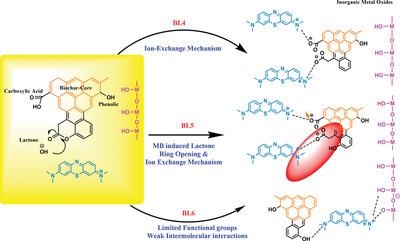当前位置:
X-MOL 学术
›
Clean - Soil Air Water
›
论文详情
Our official English website, www.x-mol.net, welcomes your
feedback! (Note: you will need to create a separate account there.)
Effect of Pyrolysis Temperature on Mechanistic Transformation for Adsorption of Methylene Blue on Leached Rice-Straw Biochar
Clean - Soil Air Water ( IF 1.5 ) Pub Date : 2022-02-09 , DOI: 10.1002/clen.202100108 Akanksha Bhardwaj 1 , Shilpa Nag 1 , Amarjeet Dahiya 2 , Puneeta Pandey 1 , Meenu Arora 3 , J. Nagendra Babu 2
Clean - Soil Air Water ( IF 1.5 ) Pub Date : 2022-02-09 , DOI: 10.1002/clen.202100108 Akanksha Bhardwaj 1 , Shilpa Nag 1 , Amarjeet Dahiya 2 , Puneeta Pandey 1 , Meenu Arora 3 , J. Nagendra Babu 2
Affiliation

|
Toxicity characteristic leaching procedure (TCLP) leached biochar is studied for adsorption of methylene blue (MB). Rice straw biochar obtained from slow pyrolysis at 400, 500, and 600 °C, respectively, is TCLP leached to furnish leached biochar, BL4, BL5, and BL6. The leached biochar BL4–6 have been characterized for pH, CHN analysis, ash, zeta potential, surface area morphology and functional groups. Batch adsorption studies are optimized for pH (3–9), adsorbent dose (0.5–4 g L−1), and initial MB concentration (20–135 mg L−1). Nonlinear fitting to Langmuir, Freundlich, and Redlich-Peterson adsorption isotherm with due statistical treatment and error function analysis is carried out. Leached biochar, BL4, BL5, and BL6, is characterized by the dominance of carboxylic acid, lactone, and phenols moieties, respectively. The MB adsorption on leached biochar exhibits maximum adsorption of 26.87, 51.34, and 18.83 mg g−1 for BL4, BL5, and BL6, respectively. The underlying mechanism for adsorption of MB using BL5, is characterized by non-ionic lactone ring opening in presence of MB under alkaline conditions that is supported by X-ray photoelectron spectroscopy(XPS) and Fourier transformed infrared spectroscopy (FTIR) studies. Desorption of MB and regeneration from BL5 is studied with methanol and 0.1 m HCl as stripping solvent for four cycles. Recovery of MB is better with methanol in comparison to 0.1 m HCl.
中文翻译:

热解温度对浸出稻草生物炭亚甲基蓝吸附机理转化的影响
毒性特征浸出程序(TCLP)浸出生物炭对亚甲基蓝(MB)的吸附进行了研究。分别在 400、500 和 600°C 下缓慢热解获得的稻草生物炭通过 TCLP 浸出,以提供浸出的生物炭 BL4、BL5 和 BL6。浸出的生物炭 BL4-6 已针对 pH 值、CHN 分析、灰分、zeta 电位、表面积形态和官能团进行了表征。批次吸附研究针对 pH (3–9)、吸附剂剂量 (0.5–4 g L -1 ) 和初始 MB 浓度 (20–135 mg L -1 ) 进行了优化)。通过适当的统计处理和误差函数分析对 Langmuir、Freundlich 和 Redlich-Peterson 吸附等温线进行了非线性拟合。浸出的生物炭 BL4、BL5 和 BL6 的特点是分别以羧酸、内酯和酚部分为主。浸出生物炭上的 MB 吸附对BL4、BL5 和 BL6的最大吸附量分别为 26.87、51.34 和 18.83 mg g -1 。使用 BL5 吸附 MB 的潜在机制的特点是在碱性条件下存在 MB 时非离子内酯开环,这得到 X 射线光电子能谱 (XPS) 和傅里叶变换红外光谱 (FTIR) 研究的支持。用甲醇和 0.1 m研究了 MB 的解吸和 BL5 的再生HCl 作为汽提溶剂进行四个循环。与 0.1 m HCl相比,甲醇的 MB 回收率更好。
更新日期:2022-02-09
中文翻译:

热解温度对浸出稻草生物炭亚甲基蓝吸附机理转化的影响
毒性特征浸出程序(TCLP)浸出生物炭对亚甲基蓝(MB)的吸附进行了研究。分别在 400、500 和 600°C 下缓慢热解获得的稻草生物炭通过 TCLP 浸出,以提供浸出的生物炭 BL4、BL5 和 BL6。浸出的生物炭 BL4-6 已针对 pH 值、CHN 分析、灰分、zeta 电位、表面积形态和官能团进行了表征。批次吸附研究针对 pH (3–9)、吸附剂剂量 (0.5–4 g L -1 ) 和初始 MB 浓度 (20–135 mg L -1 ) 进行了优化)。通过适当的统计处理和误差函数分析对 Langmuir、Freundlich 和 Redlich-Peterson 吸附等温线进行了非线性拟合。浸出的生物炭 BL4、BL5 和 BL6 的特点是分别以羧酸、内酯和酚部分为主。浸出生物炭上的 MB 吸附对BL4、BL5 和 BL6的最大吸附量分别为 26.87、51.34 和 18.83 mg g -1 。使用 BL5 吸附 MB 的潜在机制的特点是在碱性条件下存在 MB 时非离子内酯开环,这得到 X 射线光电子能谱 (XPS) 和傅里叶变换红外光谱 (FTIR) 研究的支持。用甲醇和 0.1 m研究了 MB 的解吸和 BL5 的再生HCl 作为汽提溶剂进行四个循环。与 0.1 m HCl相比,甲醇的 MB 回收率更好。











































 京公网安备 11010802027423号
京公网安备 11010802027423号